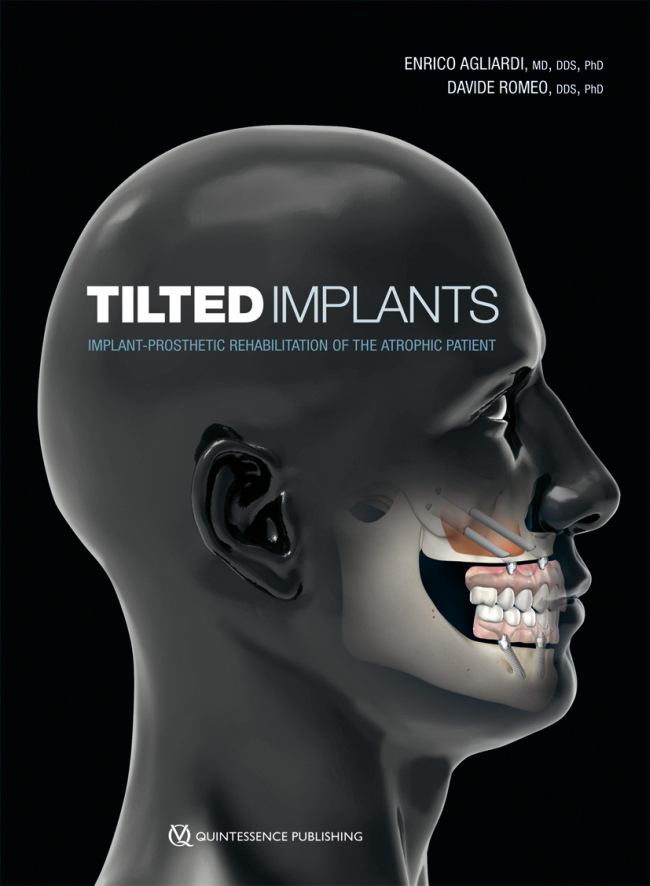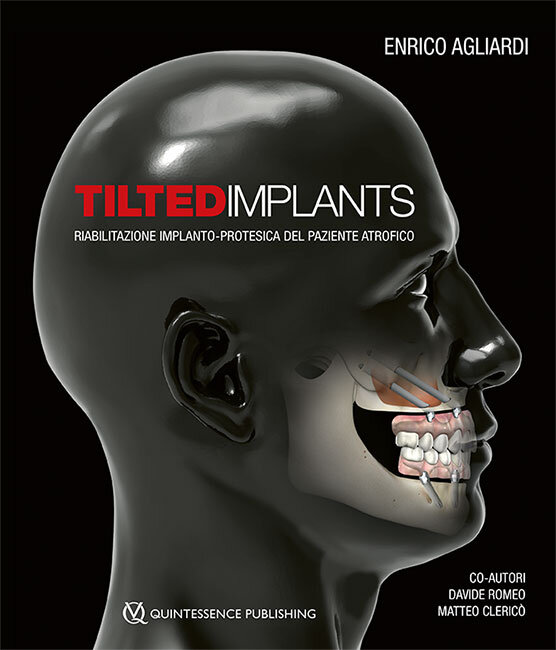The International Journal of Oral & Maxillofacial Implants, 5/2022
DOI: 10.11607/jomi.9710Pages 1003-1025, Language: EnglishDel Fabbro, Massimo / Pozzi, Alessandro / Romeo, Davide / de Araújo Nobre, Miguel / Agliardi, EnricoPurpose: To evaluate the performance of fixed complete dental prostheses supported by axial and tilted implants after at least 3 years of follow-up.
Materials and Methods: An electronic search plus a hand search up to April 2021 was undertaken. Clinical studies were selected using specific inclusion criteria, independent of the study design. The main outcomes were cumulative implant survival rate, marginal bone level changes, and complications, after ≥ 3 years of follow-up. The difference in outcomes between axial and tilted implants and between the maxilla and mandible was evaluated using meta-analysis and the Mantel-Cox test.
Results: Out of 824 articles retrieved, 24 were included. In total, 2,637 patients were rehabilitated with 2,735 full prostheses (1,464 maxillary, 1,271 mandibular), supported by 5,594 and 5,611 tilted and axial implants, respectively. In a range between 3 and 18 years of follow-up, 274 implants failed. The cumulative implant survival rate was 93.91% and 99.31% for implants and prostheses, respectively. The mean marginal bone level change was moderate, exceeding 2 mm in only two studies. Marginal bone loss was significantly lower around axial compared with tilted implants (P < .0001), whereas it was not affected by arch (maxilla vs mandible; P = .17).
Conclusion: Fixed complete dental prostheses supported by tilted and axially placed implants represent a predictable option for the rehabilitation of edentulous arches. Further randomized trials are needed to determine the efficacy of this surgical approach and the remodeling pattern of marginal bone in the long term.
Keywords: axial implants, immediate loading, mandible, marginal bone loss, maxilla, tilted implants
The International Journal of Oral & Maxillofacial Implants, 3/2012
PubMed ID (PMID): 22616046Pages 537-543, Language: EnglishBaldassarri, Marta / Hjerppe, Jenni / Romeo, Davide / Fickl, Stefan / Thompson, Van P. / Stappert, Christian F. J.Purpose: Microgaps at the implant-abutment interface allow for microbial colonization, which can lead to peri-implant tissue inflammation. This study sought to determine the marginal accuracy of three different implant-zirconium oxide (zirconia) abutment configurations and one implant-titanium abutment configuration.
Materials and Methods: Three combinations of implants with custom-made zirconia abutments were analyzed (n = 5/group): NobelProcera abutments/titanium inserts on Replace Select Tapered TiUnite implants (Nobel Biocare) (NP); Encode abutments/NanoTite Tapered Certain implants (Biomet 3i) (B3i); Astra Tech Dental Atlantis abutments/Biomet 3i NanoTite Tapered Certain implants (At). Five custom-made Encode titanium abutments/NanoTite Tapered Certain implants (Ti) were used as a control group. All abutments were fabricated with computer-aided design/computer-assisted manufacture. One-hundred twenty vertical gap measurements were made per sample using scanning electron microscopy (15 scans × 4 aspects of each specimen [buccal, mesial, palatal, distal] × 2 measurements). Analysis of variance was used to compare the marginal fit values among the four groups, the specimens within each group, and the four aspects of each specimen.
Results: Mean (± standard deviation) gap values were 8.4 ± 5.6 µm (NP), 5.7 ± 1.9 µm (B3i), 11.8 ± 2.6 µm (At), and 1.6 ± 0.5 µm (Ti). A significant difference was found between B3i and At. No difference resulted between NP with the other two groups. Gap values were significantly smaller for Ti relative to all zirconia systems. For each ceramic abutment configuration, the fit was significantly different among the five specimens. For 12 of the 15 ceramic abutment specimens, gap values sorted by aspect were significantly different.
Conclusions: The implant-titanium abutment connection showed significantly better fit than all implant-zirconia abutment configurations, which demonstrated mean gaps that were approximately three to seven times larger than those in the titanium abutment system.
Keywords: custom abutment, dental implant, marginal accuracy, titanium, zirconium oxide
The International Journal of Oral & Maxillofacial Implants, 5/2009
PubMed ID (PMID): 19865629Pages 887-895, Language: EnglishAgliardi, Enrico L. / Francetti, Luca / Romeo, Davide / Del Fabbro, MassimoPurpose: This article reports preliminary results of a single-cohort prospective study that sought to evaluate a new surgical protocol for the immediate rehabilitation of edentulous maxilla without using bone grafting.
Materials and Methods: Twenty consecutive patients in need of a full-arch maxillary rehabilitation were included in the study. Each patient received four tilted implants that engaged the posterior and the anterior sinus wall and two axial implants in the anterior maxilla. A total of 120 implants (30 Brånemark System MK IV and 90 NobelSpeedy Groovy) was inserted. Acrylic resin provisional prostheses were delivered within 4 hours of implant placement, and definitive restorations were placed 4 to 6 months later. Follow-up visits were scheduled every 6 months for the first 2 years and yearly thereafter. At each follow-up appointment, plaque and bleeding indexes were scored, periapical radiographs were obtained to assess marginal bone level changes, and patient satisfaction was recorded by means of a questionnaire.
Results: The follow-up ranged between 18 and 42 months (average, 27.2 months). No implants failed. All prostheses were stable and functional. No adverse events occurred. At 1 year, mean marginal bone loss around axial and tilted implants was similar: 0.8 mm for axial implants (SD 0.4, n = 30) and 0.9 mm for tilted implants (SD 0.5 mm, n = 60) (P > .05). Plaque and bleeding scores decreased over time, and patient satisfaction with both esthetics and function increased.
Conclusions: This technique can be considered a viable treatment modality for the immediate rehabilitation of the edentulous maxilla, as it provides optimal support in the posterior region, minimizes distal cantilevers, and avoids bone grafting or sinus augmentation.
Keywords: dental implants, edentulous maxilla, immediate function, immediate loading, tilted implants
The International Journal of Oral & Maxillofacial Implants, 3/2009
PubMed ID (PMID): 19587875Pages 511-517, Language: EnglishBellini, Chiara M. / Romeo, Davide / Galbusera, Fabio / Taschieri, Silvio / Raimondi, Manuela T. / Zampelis, Antonios / Francetti, LucaPurpose: The purpose of the study was to evaluate, using finite element analysis, the stress patterns induced in cortical bone by three distinct implant-supported prosthetic designs.
Materials and Methods: The first two models consisted of a prosthesis supported by four implants, the distal two of which were tilted, with different cantilever lengths (5 mm and 15 mm). The third design consisted of a prosthesis supported by five conventionally placed implants and a 15-mm cantilever.
Results: In the tilted model with 5-mm cantilever and in the nontilted model, the maximum value of compressive stress (-18 MPa) was found near the cervical area of the distal implant. Higher values for compressive stress were predicted near the cervical area of the distal implant in the tilted model with a 15-mm cantilever, as compared to the tilted model with the 5-mm cantilever. For the tilted model with the 5-mm cantilever, peak values of tensile stress were predicted near the cervical area of both the distal (1.25 MPa) and the mesial implants (2.5 MPa). For the nontilted model, the peak value was found near the cervical area of the in-between implant (5 MPa). For the tilted model with 15-mm cantilever, tensile stress values were higher than in the tilted model with 5-mm cantilever.
Conclusions: No significant difference in stress patterns between the tilted 5-mm and the nontilted 15-mm configuration was predicted. The tilted configuration with a 15-mm cantilever was found to induce higher stress values than the tilted configuration with a 5-mm cantilever
Keywords: biomechanics, edentulism, finite element analysis, implant-supported prosthesis, tilted implant
The International Journal of Prosthodontics, 2/2009
PubMed ID (PMID): 19418861Pages 155-157, Language: EnglishBellini, Chiara M. / Romeo, Davide / Galbusera, Fabio / Agliardi, Enrico / Pietrabissa, Riccardo / Zampelis, Antonios / Francetti, LucaThe aim of this study was to evaluate stress patterns at the bone-implant interface of tilted versus nontilted implant configurations in edentulous maxillae using finite element models of two tilted and one nontilted configuration. Analysis predicted the maximum absolute value of principal compressive stress near the cervical area of the distal implant for all models. The tilted configurations showed a lower absolute value of compressive stress compared with the nontilted, indicating a possible biomechanical advantage in reducing stresses at the bone-implant interface.






